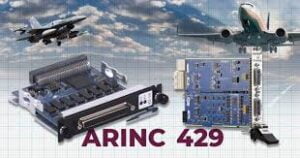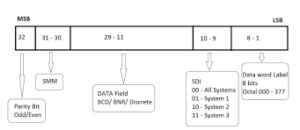The ARINC 429 protocol is a cornerstone in the aviation industry that facilitates seamless communication between avionics systems and aircraft components. This protocol was developed by Aeronautical Radio, Incorporated (ARINC) and has long ensured the reliability and safety of aerial data transfer. The background, guiding principles, and key features of the ARINC 429 protocol will all be covered in this introduction.
What is ARINC 429?
ARINC 429: ARINC Corporation is a privately held firm that is also known as Aeronautical Radio, Inc. However, it is a firm that collaborates with the Federal Aviation Administration (FAA) and the Federal Communications Commission (FCC) to develop standards for airplane communication and navigation.
It could be difficult to distinguish between business and government. ARINC provides more than only communication services. ARINC and the US military collaborated to develop military VHF radio communications in the 1940s.
The many standards listed in the ARINC standard apply to every subsystem, wiring, data bus, and database utilized in the avionic communications series 400, 500, 600, 700, and 800. Among all the ARINC standards, ARINC-429 is the most detailed specification.
Aeronautical Radio, Inc. (ARINC), a privately held business that was founded in 1929, was ultimately acquired by Collins Aerospace in 2013.
This organization was founded to provide standards or specifications for avionics hardware that may be used by airplanes all around the world. Several airlines and manufacturers of aircraft components and equipment found it.
ARINC 429 describes the basic requirements for digital data exchange between commercial avionics systems. Data transfer and design implementation are facilitated by specifying protocol features, timing, and signal levels.
ARINC 429 is meant to offer Line Replaceable Units (LRUs) for commercial aircraft. In short, the purpose of the ARINC protocol is to enable communication within the Local Area Network (LAN) of the avionics.

The architecture of the ARINC-429 Protocol
One transmitter can connect with numerous receivers using the point-to-point, unidirectional architecture of the ARINC-429 protocol. It uses a half-duplex, serial mode of operation where each data word has 32 bits. Binary and discrete are the two main data types supported by the protocol. Discrete data indicates status information or on/off states, while binary data represents numerical values.
Key Features of ARINC-429
Data Frame Structure: A structured data frame made up of a label, a data field, and a parity bit is used by ARINC-429. The data field contains the actual data, while the label indicates the kind of data being transferred. By allowing mistake detection, the parity bit guarantees data integrity.
Electrical Characteristics: A twisted pair of wires is used by ARINC-429’s differential voltage signaling method. Reliable and noise-resistant communication is ensured by the voltage levels, which represent binary values.
Data Rate and Transmission Speed: ARINC-429 has a typical data rate of 100 kbps, although there are higher-speed versions that deliver rates as high as 12.5 Mbps, including ARINC-429P2 and ARINC-429P3. With 32 bits per word, the transmission speed is expressed as words per second.
Label Selection and Assignments: A complete set of labels that specify the nature and significance of sent data is provided by ARINC-429. Because these labels are industry standard, multiple avionics systems can communicate with one another.
Word Format
The first 8 bits are designated as the wordmark in ARINC 429, whereas bits 9 and 10 represent the Source-Destination Indicator (SDI), bits 11 through 28 contain data, bits 29 through 31 represent the Sign-Status Matrix (SSM), and bit 32 is a parity bit.
ARINC 429 standard data words are 32-bit words made up of five primary fields:

- Parity – 1-bit
As a safety measure to guarantee accurate data reception, ARINC employs odd parity. Bit 32 must be set or cleared to obtain the odd count of transmitted Logic 1s in a word, which is an odd number. Error detection only—no correction technique—is specified in ARINC 429.
- Sign/Status Matrix (SSM) – 2-bits
Different information can be obtained from the SSM field depending on the word Label, which specifies the type of data being conveyed. Depending on the data type, this field can be used to report the operating status of the source system or to view the sign or position of the word information.
| Bit 31 | Bit 30 | Status (BCD) |
| 0 | 0 | Plus, North, East, Right, To, Above |
| 0 | 1 | No Computed Data (NCD) |
| 1 | 0 | Functional Test (FT) |
| 1 | 1 | Minus, South, West, Left, From, Below |
Table 1. SSM for BCD format
| Bit 31 | Bit 30 | Status (BNR) |
| 0 | 0 | Failure Warning |
| 0 | 1 | No Computed Data (NCD) |
| 1 | 0 | Functional Test (FT) |
| 1 | 1 | Normal Operation |
Table 2. SSM for BNR format
- Data – 19-bits
The bits 11–29 that comprise the word’s data information are recognized by ARINC 429 as such. The data segments—and the word itself—can be formatted in a fairly flexible way according to ARINC 429. The mark is communicated first, MSB, and the remaining bit field is transmitted first, LSB, when the data words are transmitted on the ARINC bus.
- Source/Destination Identifier (SDI) – 2-bits
According to the ARINC 429 specification, bits 9–10 are optional and utilized by the Source/Destination Identifier SDI. The data meant for the SDI may be used by many receivers or by identifying the source that transmits the data to identify the receiver. For higher-resolution data, bits 9–10 can be utilized in place of an SDI sector.
When used as an identifier, the SDI is understood as an extension of the word Label.
- Label – 8-bits
In addition to defining the word’s data type (BNR, BCD, Discrete, etc.), the mark may also include data reporting or instructive content. Bits 11–13, the first three bits of the data field, can be used as an Equipment Identifier to identify the bus transmission source, further refining the labels. Hexadecimal values are used to express equipment IDs.
The label, along with the parity bit, is always sent first in an ARINC transmission and is an essential sector. The remaining portion of the ARINC phrase is communicated by LSB first, and then labels are transmitted by MSB.
Advantages and Limitations of the ARINC-429 Protocol
Standardization: A commonly used and standardized communication protocol, ARINC-429 guarantees interoperability across various avionics device types and manufacturers.
Reliability: The dependability of the ARINC-429 protocol is well established. It is extremely resistant to noise and ensures data integrity even in demanding electromagnetic conditions thanks to the differential signaling architecture and error detection methods.
Simplicity: The ARINC-429 protocol’s simple design and data frame structure make it easier to implement and less complicated for aviation systems. For many aircraft applications, its simplicity makes it a popular option since it facilitates system integration and maintenance.
Cost-Effectiveness: Parts of ARINC-429 are widely available and widely adopted, which adds to its affordability. The protocol provides affordable options for avionics data connection with a large range of compatible devices and equipment.
Industry Support: Many avionics providers, manufacturers, and regulatory agencies support the ARINC-429 protocol. This widespread industry support guarantees that compatible devices are available and encourages the protocol’s ongoing development and improvement.
Despite its many advantages, the ARINC-429 protocol also has limitations that should be considered:
Limited Bandwidth: When numerous systems need to exchange a lot of data at once, the ARINC-429 protocol’s single-channel architecture and bandwidth limitations may become an issue. Applications that need fast data transfer might not be able to use the protocol’s 12.5 Mbps maximum data throughput.
Lack of Multicast Capability: All messages are sent individually to their intended recipients because the ARINC-429 protocol does not permit multicast communication. When more than one receiver needs the same information, this might lead to additional communication overhead and possibly impair system performance.
Conclusion:
In conclusion, an examination of the ARINC 429 protocol’s foundational elements demonstrates its significance in aviation communication systems. ARINC 429 ensures accurate real-time communication of critical information like as flight characteristics, navigation data, and system statuses by uniting avionics systems through a standardized format and strong architecture.
We have discovered that ARINC 429 uses a point-to-point communication model in which a transmitter uses a unidirectional bus to convey data to one or more receivers. It is the go-to option for many avionic applications, from flight management computers to aircraft control systems, because of its dependability and simplicity.
Furthermore, the protocol’s adaptability enables the transfer of many kinds of data, such as discrete, binary, and analog information, meeting the wide range of requirements of contemporary aircraft systems. Its adaptability is further increased by its capacity to manage various data rates and formats, guaranteeing interoperability with various avionics systems and hardware.
As aviation technology develops further, reliable and effective communication protocols such as ARINC 429 are still critical. Despite the emergence of newer protocols like ARINC 629 and ARINC 664 to address particular needs and issues, ARINC 429 remains a mainstay of aviation communication systems because of its extensive adoption and proven track record.
The ARINC 429 protocol is crucial for guaranteeing the safety, effectiveness, and dependability of air travel, and knowing its fundamentals basically gives you a strong basis for navigating the intricacies of contemporary avionics. The field of aviation communication will surely continue to change and evolve in the future as avionics technology advances, but the fundamental ideas behind protocols such as ARINC 429 will always be necessary for aircraft systems to operate internationally.






